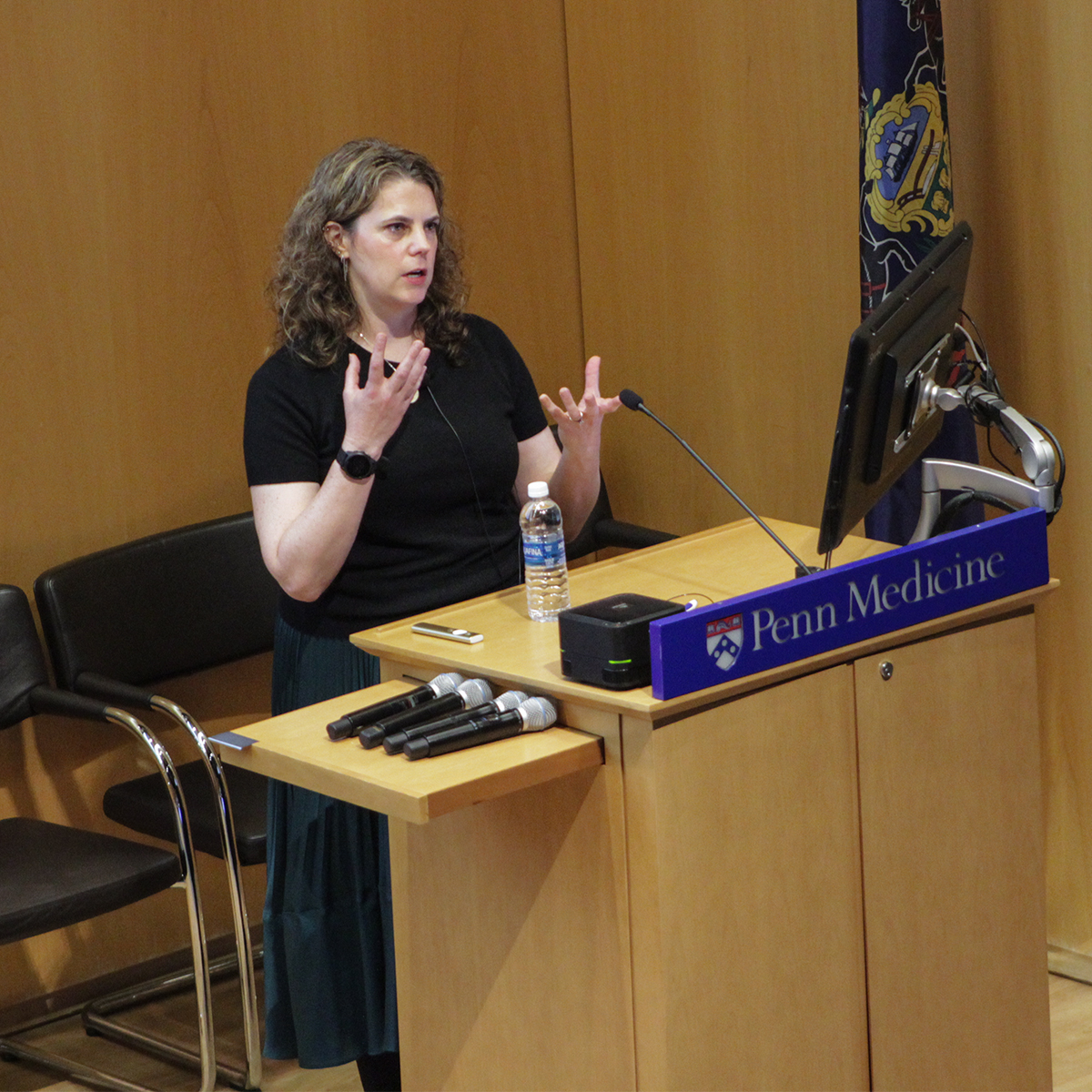Highlights from the sixth Nudges in Health Care Symposium

The Penn Medicine Nudge Unit convened an international group of health care practitioners, researchers, and leaders from nearly 30 organizations for its annual Nudges in Health Care Symposium on September 26 and 27. Gathering at the Penn’s Smilow Center for Translation, participants shared evidence-based practices, engaged in skill-building workshops, and learned about emerging trends in applying behavioral nudges designed to improve patient outcomes and clinician workflows.
In this recap, we review highlights from the 2024 program. Many sessions also are available to watch on Vimeo.
Quick, iterative trials for learning and improvement
The symposium’s opening keynote, delivered by Leora Horwitz, MD, MHS, director of the Center for Healthcare Innovation and Delivery Science at NYU Langone Health, illustrated the value of iterative, randomized trials to test and optimize interventions – and how to operationalize them within a health system. Through a series of examples, she conveyed the importance of timing and context for clinician-facing nudges; clear, concise communication with patients; and reevaluating and adjusting nudges over time – a lesson that was reaffirmed by many other speakers over the course of the symposium.
“Randomized trials don’t always give you the answers you expect, but they always teach you something valuable. Whether an intervention succeeds or fails, the process helps us understand how to better care for patients and improve our systems.” – Leora Horwitz
Horwitz also emphasized that support from the institutional leadership, IRB, IT department, and an experienced champion group are key ingredients for conducting this work, along with enthusiasm and trust from front-line staff.

AI-optimized nudging
The symposium showcased emerging work on AI-driven nudges, with discussions on how this technology can enhance intervention effectiveness by tailoring the nudges themselves and how they are deployed.
Amy Bucher, PhD, chief behavioral officer and co-director of the Behavioral Reinforcement Learning Lab at Lirio, explored how personalized nudges based on real-time patient interactions can improve patient engagement and outcomes. Her team’s use of reinforcement learning to adapt communications dynamically allows for a higher degree of customization, directly addressing individual patient needs and preferences.
Another use case came from Maria-Alkistis Iliopoulou, MBA, MPA, MSc, and Colin Shiner, ALM, MSc, of Intersystems, who leveraged machine learning to predict the likelihood patients would not show up to a hospital visit. They set up interventions accordingly and reduced no-shows by 40 percent.
África Periáñez, PhD, explained how Causal Foundry uses AI to target interventions based on individual-level predictions, offer recommendations, and optimize the allocation of limited resources. Periáñez’s team uses reinforcement learning to guide community health workers in sub-Saharan African countries, for example, and AI algorithms to recommend products for a pharmacy network in Indonesia.
Steering clinicians with decision support
Clinical decision support (CDS), which involves presenting person-specific information to guide choices in a health care context, featured in several talks. CDS nudging through the electronic health record (EHR) was also the topic of a symposium workshop led by informatics experts Srinath Adusumalli, MD, MSHP, MBMI, of CVS Health, and Joy Iocca, MSN, of Penn Medicine.

Jason Hoppe, DO, of the University of Colorado, described his team’s implementation of a CDS system to expand buprenorphine treatment of opioid use disorder in the emergency department. They designed the system to minimize burden on clinical staff and “alert fatigue” by using pre-existing EHR data and suppressing alerts when patients were already prescribed buprenorphine.
Julie Uspal, MD, of Penn Medicine, reported that adding clear indications to an order and making small changes in the EHR – adjusting the quick order list and tweaking an order name – along with providing clinicians with education and feedback helped reduce unnecessary CT scans by 64 percent.
Rebecca Hamm, MD, MSCE, of Penn Medicine, and her colleagues took a Cesarean risk calculator, which assists clinicians in making data-informed decisions on whether to induce labor – and has been shown to reduce maternal morbidity – and integrated it into the EHR workflow, bringing it within easy reach of clinicians. With this change, calculator usage jumped from 13 percent to 77 percent.
Other CDS applications included EHR-based nudges to increase screening for primary hyperparathyroidism, presented by Jasmine Hwang, MD, MS, of Penn Medicine, and for albuminuria, presented by Waleed Zafar, MD, of Geisinger. Hwang’s team leveraged electronic phenotyping to identify eligible patients, coupled with an alert or pended order. Zafar’s work showed that a storyboard format was much more effective than a best practice alert, suggesting the need for user-friendly CDS.

Fireside chat: innovation in action
A new segment of the 2024 program was a fireside chat featuring health care innovation leader Roy Rosin, MBA, in conversation with Tom Lee, MD, of Press Ganey. The two reflected on what creates a culture of innovation and reviewed successes and learnings gleaned over the past few decades. Rosin advocated for a “fail fast” approach and underscored the need to foster cross-departmental collaboration and alignment when bringing ideas to life. He also highlighted the impact of small but practical innovations, like robes that incorporate pockets for post-surgery drains, that improve patient comfort and autonomy.
Opportunities for interaction and hands-on learning
Enthusiastic conversations abounded during the symposium’s poster session and cocktail hour, when participants had a chance to explore 30 additional nudge applications from fellow attendees. The event also featured workshops to introduce useful approaches in designing and implementing nudges: rapid validation and experimentation, CDS, the COM-B behavior change framework, and service design. View photos from the poster session and workshops in the gallery below.
Reflections on the symposium from Nudge Unit staff
Visit the Nudges in Health Care Symposium web page to learn more about this annual event and view content from previous symposia.
Photos in this post are courtesy of Odelia Ghodsizadeh, Athena Lee, and Hoag Levins









 “Hosting the symposium was immensely rewarding for mutual learning, where we had the chance to share our approaches and gain fresh perspectives from leading minds across institutions worldwide. The diversity of our global audience enriched every discussion and highlighted the universal impact of behavioral science in health care.” – Neda Khan, MBA, MHCI, director of strategy and operations
“Hosting the symposium was immensely rewarding for mutual learning, where we had the chance to share our approaches and gain fresh perspectives from leading minds across institutions worldwide. The diversity of our global audience enriched every discussion and highlighted the universal impact of behavioral science in health care.” – Neda Khan, MBA, MHCI, director of strategy and operations “Many conferences focus on a single domain within health care such as cancer or substance use. In contrast, the Nudge symposium fosters conversations across countries and health care domains. In this way, we can significantly enhance both our research practices and the administration of health care.” – Hannah Dart, MS, clinical research coordinator
“Many conferences focus on a single domain within health care such as cancer or substance use. In contrast, the Nudge symposium fosters conversations across countries and health care domains. In this way, we can significantly enhance both our research practices and the administration of health care.” – Hannah Dart, MS, clinical research coordinator “I loved the energy attendees brought to our workshops and the diversity of experiences and expertise they shared with one another.” – Jeff Ebert, PhD, director of applied behavioral science
“I loved the energy attendees brought to our workshops and the diversity of experiences and expertise they shared with one another.” – Jeff Ebert, PhD, director of applied behavioral science “Leora Horwitz’s presentation resonated with me—her comment about ensuring a nudge impacts more than just the primary outcome made me reflect on how we can thoughtfully consider all possible behaviors that may arise from our interventions and remain mindful of them throughout the design process. I also witnessed engaging conversations, networking, and valuable feedback on the interventions presented in the posters. We’re excited and energized by the potential to continue growing in the behavioral science field, ultimately working toward our goal of improving patient and clinician outcomes.” – Arleen Lopez Cruz, clinical research coordinator
“Leora Horwitz’s presentation resonated with me—her comment about ensuring a nudge impacts more than just the primary outcome made me reflect on how we can thoughtfully consider all possible behaviors that may arise from our interventions and remain mindful of them throughout the design process. I also witnessed engaging conversations, networking, and valuable feedback on the interventions presented in the posters. We’re excited and energized by the potential to continue growing in the behavioral science field, ultimately working toward our goal of improving patient and clinician outcomes.” – Arleen Lopez Cruz, clinical research coordinator “It was exciting to see how AI and behavioral science are coming together to create personalized nudges that make a real difference in preventive care. Hearing about the success stories and creative ways to engage patients was a great reminder of just how powerful personalized care and thoughtful nudges can be in improving health outcomes.” – Athena Lee, MA, clinical research coordinator
“It was exciting to see how AI and behavioral science are coming together to create personalized nudges that make a real difference in preventive care. Hearing about the success stories and creative ways to engage patients was a great reminder of just how powerful personalized care and thoughtful nudges can be in improving health outcomes.” – Athena Lee, MA, clinical research coordinator